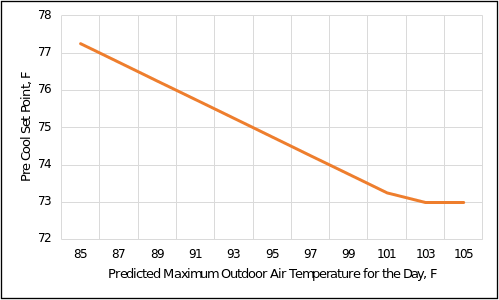Appropriate demand response controls allow building operators to reduce TDV energy by automating the response of a building to changes in utility costs. Demand response is an increasingly important function as distributed energy resources become more common, as customers have access to time-of-use (TOU) electricity rates, and incentive programs are designed to encourage customers to reduce energy use during peak demand. Demand response occurs on a range of timescales from seconds to seasons and represents any demand change in response to grid or economic needs.
Precooling represents a program where special thermostats in homes receive signals from the local utility that alter the occupant’s normal behavior to reduce air conditioning energy consumption during peak electricity demand periods. The house is precooled to a lower than normal set-point in the hours preceding the onset of the peak and then the thermostat is returned to the normal setting for the peak period. The thermal mass of the structure and furnishings absorbs the cooling load as the house warms up allowing the cooling system to remain off for most, or all, of the highest peak period hours.
CBECC-Res Precooling simulations alter the thermostat set-points only during daylight hours on days when the average daily outdoor temperature is greater than 78 F and the peak hourly TDV values are in the top 20 for the year. On those days, the precooling period thermostat setpoint depends on the predicted outdoor temperature for the day as plotted in Figure 1.
Figure 1: Precooling Thermostat Set point

Source: California Energy Commission
The savings due to Precooling are reduced by 70% to account for occupant behavior that might reduce its effectiveness in real homes.


